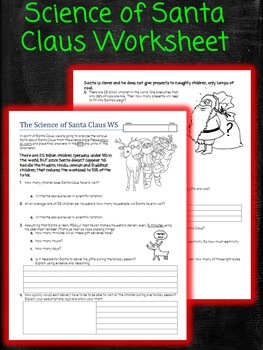Science of Santa Claus Worksheet
Mrs Lyons
463 Followers
Resource Type
Standards
CCSS7.RP.A.1
CCSSHSN-Q.A.1
CCSSHSN-Q.A.2
CCSSHSN-Q.A.3
CCSSMP1
Formats Included
- Word Document File
Pages
2 pages
Mrs Lyons
463 Followers
Description
This a hilarious worksheet designed for student to practice their problem solving and math skills. Just look at the two preview questions.
Perfect for that last school day before the winter or Christmas holiday break. Reviews concepts: percent, rate, dimentional analysis, heat transfer, time calculations.
Allows students to practice their Common Core Math Skills!
Works great for both math and science classes.
Besides, who wouldn't want to do some real math on whether Santa Clause is real.
The worksheet is double-sided black and white. Fully editable! Answer key is included.
Perfect for that last school day before the winter or Christmas holiday break. Reviews concepts: percent, rate, dimentional analysis, heat transfer, time calculations.
Allows students to practice their Common Core Math Skills!
Works great for both math and science classes.
Besides, who wouldn't want to do some real math on whether Santa Clause is real.
The worksheet is double-sided black and white. Fully editable! Answer key is included.
Total Pages
2 pages
Answer Key
Included
Teaching Duration
50 minutes
Last updated Dec 15th, 2014
Report this resource to TPT
Reported resources will be reviewed by our team. Report this resource to let us know if this resource violates TPT’s content guidelines.
Standards
to see state-specific standards (only available in the US).
CCSS7.RP.A.1
Compute unit rates associated with ratios of fractions, including ratios of lengths, areas and other quantities measured in like or different units. For example, if a person walks 1/2 mile in each 1/4 hour, compute the unit rate as the complex fraction ½/¼ miles per hour, equivalently 2 miles per hour.
CCSSHSN-Q.A.1
Use units as a way to understand problems and to guide the solution of multi-step problems; choose and interpret units consistently in formulas; choose and interpret the scale and the origin in graphs and data displays.
CCSSHSN-Q.A.2
Define appropriate quantities for the purpose of descriptive modeling.
CCSSHSN-Q.A.3
Choose a level of accuracy appropriate to limitations on measurement when reporting quantities.
CCSSMP1
Make sense of problems and persevere in solving them. Mathematically proficient students start by explaining to themselves the meaning of a problem and looking for entry points to its solution. They analyze givens, constraints, relationships, and goals. They make conjectures about the form and meaning of the solution and plan a solution pathway rather than simply jumping into a solution attempt. They consider analogous problems, and try special cases and simpler forms of the original problem in order to gain insight into its solution. They monitor and evaluate their progress and change course if necessary. Older students might, depending on the context of the problem, transform algebraic expressions or change the viewing window on their graphing calculator to get the information they need. Mathematically proficient students can explain correspondences between equations, verbal descriptions, tables, and graphs or draw diagrams of important features and relationships, graph data, and search for regularity or trends. Younger students might rely on using concrete objects or pictures to help conceptualize and solve a problem. Mathematically proficient students check their answers to problems using a different method, and they continually ask themselves, "Does this make sense?" They can understand the approaches of others to solving complex problems and identify correspondences between different approaches.



